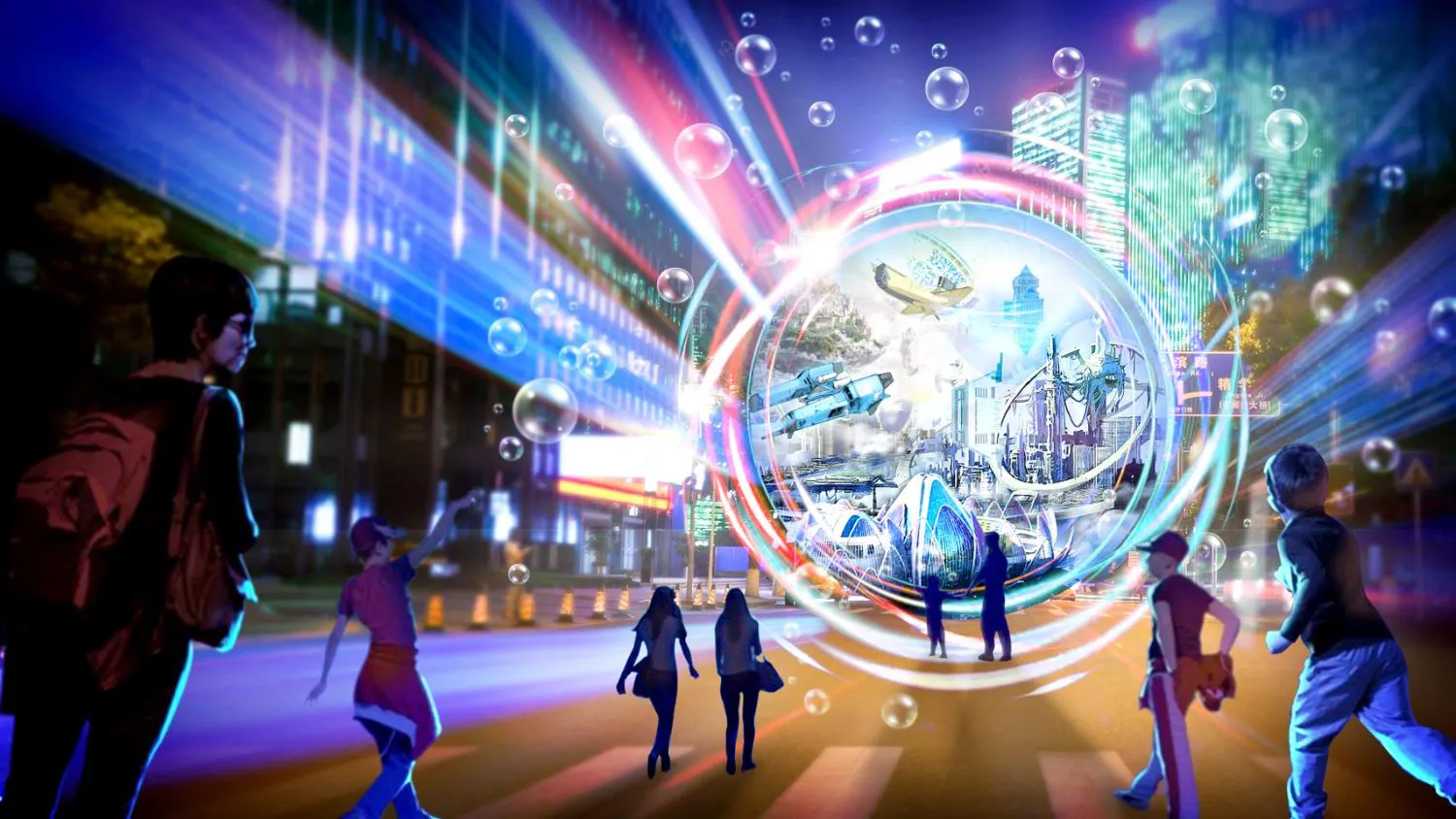During the pandemic, many digital developments were accelerated. Due to the lock-downs and working from home, a lot of communication moved to the digital world. Partly because of this, we have become used to being together in the online virtual world. As a result, the concept of the Metaverse has attracted a great deal of attention in the past two years and a number of the necessary technical building blocks have become available at an accelerated pace. In short, we have become accustomed to virtual consultation, entertainment and social togetherness…. also in customer contact.
What is the Metaverse?
The Metaverse is an online network of real-time virtual three-dimensional worlds. It can be seen as a conversion or upgrade of the currently two-dimensional, flat internet into a new three-dimensional, spatial form through the addition of new technology. In the Metaverse, we control more and more interactions with physical gestures, eye movements and voice. Connections between virtual and physical reality are being realised. This means that Metaverse is more than just a virtual web. A visitor to the Metaverse gains a sense of individual presence and spatial awareness. Access to the Metaverse is possible through various devices, including tablets, smartphones and virtual reality devices.

Because it is a digital environment, as a visitor you can be and move in different guises and in different ways. Digital identities that people currently possess (such as social media profiles) will also play a role in the Metaverse, with the difference that identity is not limited to a name and a photograph, but can also be a virtual figure (human avatar) that can communicate in real time, move and change shape.
The Metaverse as an ideal space for multimodal customer interaction
If all the good ideas work out, the Metaverse will be relevant to customer contact professionals within a few years. What is the significance of the Metaverse for customer contact? Is it part of omni-channel customer contact? What can companies do with it? The Metaverse can best be seen as a new development phase of the internet. By combining various new technologies – all of which have already been proven – something is added to our current internet, which is mainly played out on a flat screen. With the Metaverse, that becomes 3D. If you’re looking for a website now, you’re usually alone. In the Metaverse, we are together in a digital space where we can see each other and communicate in real time.

Who are we in the Metaverse?
People can enter the Metaverse in different ways: You can walk around as your digital self – in the form of a 3D human avatar or a synthetic representation of yourself. In different spaces, you can take on different capacities, just like in real life: at carnival you look different than when you’re playing sports or at a business dinner. The spaces in the Metaverse are mostly based on open standards, which means that you can, for example, pay for digital possessions with cryptos and take them to other spaces. Data sovereignty should be a starting point anyway, but you will have to identify yourself in different places if you want to do transactions. On the other hand, if you move around in parts of the Metaverse, you have to take into account that parts of that route are also recorded.
Our imagination as a boundary
The physical world and the Metaverse will soon blend into one another more and more. Think of a smart mirror with augmented reality in a fashion shop, where you are physically present and you, but also others (regardless of the physical location) can see how certain clothes look on you. Or a digital meeting in a meeting, seminar or, for example, a sports lesson. Artificial intelligence will play a big role in the Metaverse. AI can be used for customer contact, where an automated avatar (of any celebrity) can answer visitors’ questions and read out information in any language. As often, as clearly, as quickly as the visitor wants, 24 hours a day, 7 days a week. But the AI can also be used to quickly create new environments and experiences in the Metaverse, based on imagination and through simple text or voice input: ‘I would like a blue mansion with a green roof and a balcony in front’ or ‘make a chair in the shape of an avocado’. With our imagination as the only limit.

What can customer service do with the Metaverse?
We at Telecats have high expectations regarding the significance of the Metaverse for customer service. We have started to cooperate much more digitally because of the corona pandemic. It looks like hybrid working will continue, especially in customer contact. You don’t want to limit that to meetings in Teams or Zoom. The Metaverse lends itself very well to real-time digital collaboration. Moreover, it is an environment that you can set up completely as you wish, so you can also use it to create a virtual, inspiring contact centre environment. And you can create suitable environments for different consultations to promote creative co-creation.
The Metaverse is also extremely suitable for sales or service objectives. As a customer, you may go to the Metaverse together with an employee; for example, to have questions about products answered in a virtual space. For example: Think about art or a TV screen: does it fit in your own living room? Or how do you solve connection problems? In a virtual space, you can easily give explanations using virtual devices. You can also make an appointment with someone to go digital shopping together in real time. Or you can have customers meet for product demonstrations.
From that application it is only a small step to training in customer contact, where you have employees meet virtually in a room. Here, you can tailor the space to a specific context and purpose. Why would you want new employees to come to the office immediately? In addition, when it comes to retention, verbal information transfer combined with showing and experiencing works much better than just reading.
How do we get into the Metaverse?
The VR headset, your mobile phone, your computer screen, the smart mirror in a shop: these are the devices that will soon give access. Of course, it is not practical to have to wear heavy VR glasses for a long time. Moreover, at present they still isolate you from the outside world. The technology to make this easier and better is already there, think of semi-permeable screens and 3D projections. Perhaps we will be projecting more and looking less at screens in a few years’ time.
Nike is a good example of a company that has set up a space on Metaverse. The company has launched ‘Nikeland’ on a gaming platform. Nikeland looks like the brand’s headquarters, where visitors can play virtual games, design games, and shop. The company itself can test out new products there and will be selling real and virtual trainers and clothing.
Adding the Metaverse to your WFM solution
The question remains as to what companies should do to offer customer contact in the Metaverse. For customer service departments, the Metaverse is a new form of online presence, familiar territory. Just as you have people walking around in your physical shop, you will also have to schedule staff to speak to customers in the Metaverse, or staff who may take over conversations from automated avatars in the Metaverse. In any case, customer contact in the Metaverse will be multimodal: you can talk, exchange messages, and show things. So in many cases you will be able to reach a solution faster.

What does the future of the Metaverse look like?
There are already Metaverse-like virtual environments. Especially in the gaming industry, such as: Nikeland, Fortnite, Roblox and Minecraft but also Facebook which recently adopted the name Meta, has a virtual platform called Horizon.
Completely new professions will emerge. For example, around the creation of content, events and the delivery of products to other users. Think of: a designer of virtual events or virtual clothing such as skins and wraps; a real estate agent in virtual real estate; a financial advisor specialising in crypto currencies; or an interior designer for decorating your home, creative workplace and office spaces in the Metaverse.

But, it is far from finished. The Metaverse is in part still a future vision. The actual completion of the Metaverse may take years. But the technical foundations are being laid right now.
The current Internet will certainly not disappear with the arrival of the Metaverse. For some applications you use the traditional Internet, while for others you log on to the Metaverse. Just as there are some activities you would rather do on your smartphone than on your laptop, or vice versa, there are some things you would rather do in the future on the two-dimensional flat Internet than in the three-dimensional Metaverse.
